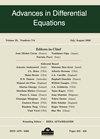结构在齐次Hörmander向量场上的非发散算子:热核和全局高斯边界
IF 1.9
3区 数学
Q1 MATHEMATICS
引用次数: 2
摘要
设$X_{1},。。。,X_{m}$是在$\mathbb{R}^{n}$中定义的实光滑向量场族,$1$-关于非各向同性扩张族是齐次的,并且在$0$处满足Hormander秩条件(因此在$\math bb{R}^{n}$的每一点上)。向量场不被假设为相对于任何李群结构是平移不变的。让我们考虑非变量进化算子$$\mathcal{H}:=\sum_{i,j=1}^{m}a_{i,j}(t,x)x_{i}X_{j}-\partial_{t}%$$,其中$(a_{i,j}(t,x))_{i,j=1}^{m}$是对称一致正$m\times m$矩阵,并且条目$a_{ij}$为$\mathbb{R}^{1+n}$上的有界Holder连续函数,关于向量场引起的“抛物线”距离。我们证明了全局热核$\Gamma(\cdot;s,y)\在C_{X,\mathrm{loc}}^{2,\alpha}(\mathbb{R}^{1+n}\setminus\{(s,y_{i}X_{j} \Gamma$在每个条带$[0,T]\times\mathbb{R}^n$上满足高斯上界。我们还证明了$\mathcal{H}$的一个标度不变的抛物型Harnack不等式,以及相应平稳算子$\mathical{L}:=\sum_{i,j=1}的一个标准Harnack定理^{m}a_{i,j}(x)x_{i}X_{j} .$$具有Holder连续系数。本文章由计算机程序翻译,如有差异,请以英文原文为准。
Non-divergence operators structured on homogeneous Hörmander vector fields: heat kernels and global Gaussian bounds
Let $X_{1},...,X_{m}$ be a family of real smooth vector fields defined in $\mathbb{R}^{n}$, $1$-homogeneous with respect to a nonisotropic family of dilations and satisfying Hormander's rank condition at $0$ (and therefore at every point of $\mathbb{R}^{n}$). The vector fields are not assumed to be translation invariant with respect to any Lie group structure. Let us consider the nonvariational evolution operator $$ \mathcal{H}:=\sum_{i,j=1}^{m}a_{i,j}(t,x)X_{i}X_{j}-\partial_{t}% $$ where $(a_{i,j}(t,x))_{i,j=1}^{m}$ is a symmetric uniformly positive $m\times m$ matrix and the entries $a_{ij}$ are bounded Holder continuous functions on $\mathbb{R}^{1+n}$, with respect to the "parabolic" distance induced by the vector fields. We prove the existence of a global heat kernel $\Gamma(\cdot;s,y)\in C_{X,\mathrm{loc}}^{2,\alpha}(\mathbb{R}^{1+n}\setminus\{(s,y)\})$ for $\mathcal{H}$, such that $\Gamma$ satisfies two-sided Gaussian bounds and $\partial_{t}\Gamma, X_{i}\Gamma,X_{i}X_{j}\Gamma$ satisfy upper Gaussian bounds on every strip $[0,T]\times\mathbb{R}^n$. We also prove a scale-invariant parabolic Harnack inequality for $\mathcal{H}$, and a standard Harnack inequality for the corresponding stationary operator $$
\mathcal{L}:=\sum_{i,j=1}^{m}a_{i,j}(x)X_{i}X_{j}.
$$
with Holder continuos coefficients.
求助全文
通过发布文献求助,成功后即可免费获取论文全文。
去求助
来源期刊

Advances in Differential Equations
MATHEMATICS, APPLIED-MATHEMATICS
CiteScore
1.90
自引率
0.00%
发文量
0
审稿时长
>12 weeks
期刊介绍:
Advances in Differential Equations will publish carefully selected, longer research papers on mathematical aspects of differential equations and on applications of the mathematical theory to issues arising in the sciences and in engineering. Papers submitted to this journal should be correct, new and non-trivial. Emphasis will be placed on papers that are judged to be specially timely, and of interest to a substantial number of mathematicians working in this area.
 求助内容:
求助内容: 应助结果提醒方式:
应助结果提醒方式:


